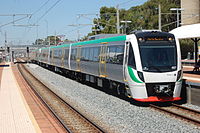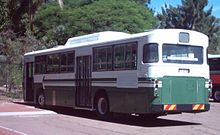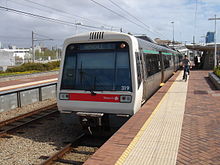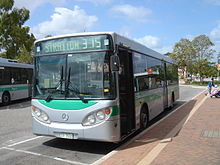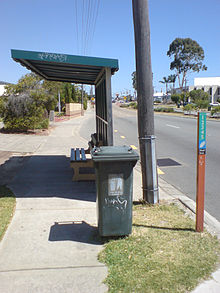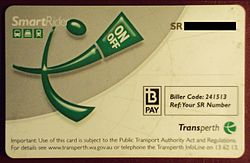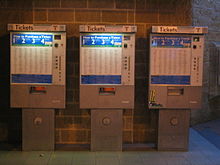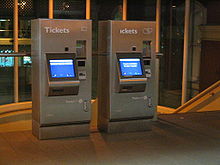- Transperth
-
Transperth 
The new B Series trains delivered in 2004 service the Joondalup and Mandurah Lines and some special services on other linesInfo Locale Perth, Western Australia Transit type Bus, Train, Ferry Website transperth.wa.gov.au Call Centre 13 62 13 Operation Operator(s) Public Transport Authority Transperth is the brand name of the public transport system in Perth, Western Australia. It is operated by the Public Transport Authority.
Contents
History
The Transperth brand was launched in August 31, 1986 as part of a series of reforms integrating Perth's public bus, ferry and rail services.[1] Initially Transperth services were coordinated by the Metropolitan Transport Trust (MTT), with MTT operating bus and ferry services itself and coordinating rail services operated by Western Australian Government Railways (WAGR) under the Westrail brand. In 1993 control of Transperth was transferred to the Department of Transport.[1]
Between 1994 and 1998 Transperth began contracting out its bus, ferry and customer service operations. Buses and ferries are now publicly owned but privately operated. On 1 July 2003 Transperth was again transferred, along with WAGR's passenger transport operations, to the newly formed Public Transport Authority.[2]
Services
Transperth offers bus, train and ferry services which currently serve the Perth metropolitan area from the Perth City, east to Wundowie, west to Fremantle, south to Mandurah and north to Two Rocks. These suburbs are divided into nine fare-zones according to distance from the city centre.
Train
Transperth Trains operates Perth's suburban rail services. The system consists of 70 stations on six narrow-gauge lines, running to Midland, Armadale, Fremantle, Clarkson (terminus of the Joondalup line) and Mandurah. Trains to Thornlie run via a spur off the Armadale Line.
Services operate from 5:00am until midnight (until 2:00am on Saturday and Sunday mornings) with a minimum frequency of 2–15 minutes until 7:30pm and 30 minutes until midnight, 15 minutes weekday and weekend (including public holidays). Post midnight services on Saturday and Sunday mornings operate on one-hour frequency to 2.15am. A 4am service is currently undergoing a trial which will run until April. In 2005 the network accommodated 32.652 million passenger boardings.[3] This rose to 42.636 million boardings in 2007/08 and 54.750 million passenger boardings in 2008/09. [4]
The network has been served exclusively by electric multiple unit railcars since it was electrified in the 1990s. Before that time diesel locomotive-hauled trains and diesel multiple units were used.[5]
Transperth Trains Buses
Unlike the Perth suburban train services, the bus services in Perth are operated by three companies, which are contracted with the Public Transport Authority, Government of Western Australia, under the Transperth brand name. This arrangement has been in place since 1996.
Transperth oversees and regulates a bus service throughout the Perth metropolitan area and some fringe rural areas. Transperth buses are privately operated, but publicly owned.[5] Routes follow two basic formats: feeder services between residential suburbs and bus stations or bus\train interchanges, and routes directly to the CBD. There are also some cross-suburban services, most notably the CircleRoute. Additional services are provided for schools and special events. Transperth's most frequent bus routes run from 5am to midnight with services generally every 4–15 minutes on weekdays and every 30 minutes on evenings and weekends. Most other local routes run every 10 – 60 minutes, with reduced service on evenings and weekends. Services to and from railway stations are normally co-ordinated to connect with every, every second or every fourth train.
Transperth is currently purchasing Mercedes-Benz OC500LE compressed natural gas-fuelled buses. They comply with the Euro 4 emission standard and operate on locally produced Western Australian natural gas.[6]
There were 65.694 million passenger boardings on Perth bus services in 2007/08, with an increase of 12.0% to 73.550 million passenger boardings in 2008/09. [4]
Special services
CircleRoute: The CircleRoute is a cross suburban route that links numerous railway stations, shopping centres, universities, schools and the port town of Fremantle. Services run 5–15 minutes weekdays and 10–30 minutes weekends and public holidays.
CAT: Transperth operates CAT (central area transit) bus services around the Perth, Fremantle and Joondalup CBDs. Services run every 5 – 15 minutes on weekdays and every 15 – 30 minutes on weekends.
In Perth there are 3 routes:
- Red CAT: Southern East Perth to West Perth route
- Yellow CAT: Northern East Perth to West Perth route
- Blue CAT: North to South
In Joondalup there are 2 routes:
- Route 10: CBD loop (anticlockwise)
- Route 11: CBD loop (clockwise)
And in Fremantle:
- Orange CAT: Fremantle CBD loop.
NightRider: Transperth's late night bus service is NightRider, which leaves Fremantle Saturday nights hourly from 1-4am:
- Route 697 to Como
- Route 699 to Bullcreek
Airport services: Transperth operates a bus service to the airport:
- Route 37 Kings Park to the Domestic Terminal
Transperth also operate school services and special event services.
Timetables
Timetables are colour coded: Northern timetables are green, Eastern timetables are red, South Eastern timetables are yellow, Southern timetables are orange, and Western timetables are blue. Timetables are numbered from 1 to 134, with gaps left at the end of each region for future expansion. Special services such as CAT buses are also colour coded, with Joondalup and Perth CAT timetables being grey, Fremantle CAT timetables orange, CircleRoute timetables pale blue/aqua, and Rockingham shuttles (Southern 127) orange with a dolphin on the front.
Ferries
Transperth operates a ferry service across the Swan River between Barrack Street (Perth CBD) and the South Perth foreshore. Services departs twice an hour and every 15 minutes during peak. The ferry is popular with commuters and tourists who use it to get to the Perth Zoo. There are currently two Transperth ferries, the 'Shelley Taylor-Smith' and the 'M/V Phillip Pendal,' which was named in a competition.[6]
Passenger information
TravelEasy
TravelEasy sends customers an email notification when there are disruptions and changes to their nominated services. The service was introduced in 2003. TravelEasy also provides a SmartRider link facility, allowing customers to check card balances and add value.
The TravelEasy service will only e-mail subscribers for major significant disruptions, which are planned ahead. General day-to-day disruptions (technical difficulties, overheating engines etc.) which may cause delays of up to two hours will not be notified to travellers.
Google transit
Perth became the first city in Australia to use Google transit, whereby all bus stops/stations, train stations and ferry wharfs have a clickable symbol on Google Maps which reveals the next departures from that stop. Also, public transport is available as an option for Google Maps' directions feature. [7]
Live train times
As of 10 December 2009, the TravelEasy users can view the live train times to see whether the train services is on time or not as well as live departure times.[8] This service has now been made available to all commuters, and a cut-down version has been placed on 136213.mobi.
136213.MOBI
The 136213.MOBI service was launched at 10 June 2008.[9] The service allows for public transport information, such as upcoming departures, service changes and SmartRider balances, to be obtained on a WAP-compatible mobile phone.
Ticketing
The methods and types of tickets used on the network continue to change with the progression of time and technology. Today, passengers on the network can either purchase a cash ticket from any ticket vending machine at a train stations, from a ferry wharf, or bus driver or use a re-loadable stored-value card known as SmartRider.
Fares are calculated on a zone-based system starting from 2-sections to 9 Zones and charged at either Standard or Concession rates. Concession rates are available to children under the age of 15 years, persons over the age of 60 possessing a Senior's Card, students of Primary, Secondary, and Tertiary schools possessing a SmartRider with valid concession status, and those in the receipt of various state and commonwealth pensions with acceptable proof of that status. DayRider and FamilyRider tickets are also available. Passengers to some special events such as football matches can travel free with a valid ticket to the event.
Some additional fare classes exist within the system and include:
Fare type Details DayRider valid for all zones, all day (Only for purchase and use after 9am on weekdays) FamilyRider unlimited travel for 7 passengers (including 2 adults.) Available all day on weekends and public holidays, after 9am on school holidays, after 6pm Monday to Thursday (school days) and after 3pm Friday (school days) Seniors SmartRider Available for seniors, valid for free travel on all days between 9am and 3.30pm, as well as weekends / Public Holidays and Senior's week. (replacing the Senior MultiRider) Student SmartRider Available for primary and secondary school students as well as full time university students. (replacing the Student MultiRider) Previous methods
In the early 1990s, the network changed over from the use of train conductors with old rotary paper ticketing units and installed self-service ticket vending machines supplied by the Switzerland-based company Ascom. The same rotary units in place on buses were replaced with technology supplied by the UK-based company Wayfarer Transit Systems.
Also at the same time, an upgraded version of the pre-encoded multi-trip ticket system MultiRider was introduced, also relying on technology from Wayfarer.
Changes
In March 2007, the Public Transport Authority commenced a trial of upgraded ticket vending machines installing two new units on the Eastern concourse at Perth Station and all Mandurah Line Train Stations.
These trial units are based on touch-screen technology, and provide an expanded number of options including being able to purchase multiple quantities of tickets at the same time, as well as optionally being able to pay using either notes or Electronic funds transfer from a cheque or savings account using a Debit card, dependent on these components being installed in the unit. These are now installed in all train stations in place of the older TVMs.
In 2007 the MultiRider ticketing system was replaced with the Smartrider ticketing system which uses contactless electronic ticketing system using smartcard technology for the process of charging patrons for public transport.
The SmartRider is a credit card-sized smartcard incorporating a microchip and internal aerial, allowing the smartcard to communicate with processors located on Transperth buses and ferries and at train stations. The microchip enables value to be loaded onto the card, as well as allowing the journey details to be recorded and the appropriate fare deducted from the stored value on the card.
Free Transit Zone
A feature of the network is an area in the central business district known as the Free Transit Zone (FTZ). Travel on buses and CAT buses within the FTZ zone is free for all passengers.
On the rail network, however, free travel within the zone is only available to passengers who have purchased a SmartRider card. This was not always the case, but is now required due to changes in station structures brought about by the implementation of the SmartRider ticketing system.[10]
Proposals
A new 20 year rail expansion plan was released before the 2008 Western Australia state election by then-premier, Alan Carpenter. The plan includes a link to Ellenbrook via the Midland line, the extension of the Armadale Line to Byford, the extension of the Joondalup line to Yanchep, new stations on the Mandurah line, a spur rail to Perth Airport, and new South West links, connecting other retail centres, hospitals, airports, universities and communities. The rough system map was to be released after the state election.
It has since been announced that the Joondalup Line will be extended from Clarkson to Butler by the end of 2014.
Roe Street Bus Bridge
In mid 2008, construction began on the $14 million Roe Street Bus Bridge, which was to be completed by early 2009. According to the signage displayed the bridge was to:
- Return an extra lane on Roe Street to traffic
- Remove the inefficient bus level crossing
- Reduce travel time for 19,000 passengers
- Connect Wellington Street Bus Station with Fitzgerald Street
However, the construction went over-time and over-budget and in July 2009 the Public Transport Authority announced the bridge and modifications to James and Fitzgerald streets would not be finished until early 2010, with a $2 million cost blowout.[11] As of December 2010, the buses that previously used the railway crossing near Harbour Town now travel via the new bridge
2031 Plan
The State Government is currently drawing up plans for an expansion of the rail network, construction of a light rail network, and creation of rapid transit bus services. The plan includes:
- Extending the Joondalup line to Yanchep
- Building a spur line to the airport
- Constructing at least one new station on the Mandurah line at Karnup
- Constructing a light rail network to serve the CBD, Curtin University, UWA, Subiaco, QEII Medical Centre, Mirrabooka and Stirling
- Creating a rapid transit bus network.
Other long term plans include extending the Armadale line to Byford and connecting the Thornlie line to the Mandurah line at Cockburn Central. [12]
Operators
Bus
Train
Ferry
- Captain Cook Cruises
Call centre
- Serco Australia
See also
- List of Perth railway stations
- List of Perth bus stations
- List of Perth bus routes
- Transwa - also run by the Public Transport Authority, controls public transport in Western Australia, outside Perth.
- TransGoldfields - public bus service in the City of Kalgoorlie-Boulder
- Northern Suburbs Transit System - rail network expansion project from the late 1980
- New MetroRail - second rail network expansion project
References
- ^ a b "PTA history at a glance: 1976 to 2000". www.pta.wa.gov.au. Archived from the original on 2008-03-11. http://web.archive.org/web/20080311154540/http://www.pta.wa.gov.au/scripts/viewarticle.asp?NID=1823. Retrieved 2008-05-08.
- ^ "PTA history at a glance: 2001 to present". www.pta.wa.gov.au. Archived from the original on 2008-03-11. http://web.archive.org/web/20080311164317/http://www.pta.wa.gov.au/scripts/viewarticle.asp?NID=1824. Retrieved 2008-05-08.
- ^ "PTA Annual Report: 2005". www.pta.wa.gov.au. Archived from the original on 2008-04-11. http://web.archive.org/web/20080411053838/http://www.pta.wa.gov.au/annualreports/2005/download/pta_annualreport.pdf. Retrieved 2008-05-08.
- ^ a b "PTA Annual Report: 2009". www.pta.wa.gov.au. http://www.pta.wa.gov.au/Portals/0/annualreports/2009/audited-key-performance-indicators/index.html. Retrieved 2009-12-30.
- ^ "PTA history at a glance: 1951 to 1975". www.pta.wa.gov.au. Archived from the original on 2008-03-11. http://web.archive.org/web/20080311164315/http://www.pta.wa.gov.au/scripts/viewarticle.asp?NID=1822. Retrieved 2008-05-08.
- ^ "New ferry named after popular former South Perth MP". www.pta.wa.gov.au. http://www.pta.wa.gov.au/scripts/viewarticle.asp?NID=2685. Retrieved 2009-05-18.[dead link]
- ^ "What's New". Transperth. http://www.transperth.wa.gov.au/WhatsNew/tabid/368/newsid1559/1116/Default.aspx. Retrieved 2010-01-20.
- ^ Live Train Times, Transperth website, 2009 (accessed 12/12/09)
- ^ 136213.MOBI by Transperth, accessed 2008-06-10
- ^ Free Transit Zone Transperth website, accessed 2007-10-03
- ^ "Bus bridge six months away". Wanneroo Times. 2010-05-23. http://www.inmycommunity.com.au/news-and-views/local-news/Bus-bridge-six-months-away/7548707/. Retrieved 2010-02-26.
- ^ Department of Transport, 2011, Public Transport for Perth in 2013: Mapping out the future for Perth's public transport network (summary), Retrieved: July 16, 2011, from http://www.transport.wa.gov.au/mediaFiles/ABOUT_P_PT_Plan2031Summary.pdf
External links
- Public Transport Authority's website
- Transperth website
- Transwa website
- 136213.MOBI (Transperth mobile website)
- Transperth on Twitter
- Live Train Times Chrome Extension
Public Transport Authority Transperth • Transwa • TransBunbury • TransGeraldton • TransGoldfields • New MetroRail • TransBusselton • Loves bus service Rail transport in Australia
Rail transport in AustraliaBy state 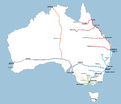
By capital Stations Misc Bus transport in Australia Adelaide • Brisbane • Bunbury • Canberra • Cairns • Darwin • Geelong • Gold Coast • Hobart • Ipswich • Kalgoorlie • Logan City • Mackay • Melbourne • Newcastle • Perth • Rockhampton • Sunshine Coast • Sydney • Townsville • Toowoomba • Wagga Wagga • WollongongCategories:- Public transport in Perth, Western Australia
- Intermodal transport authorities in Australia
- Australian regional rail systems
Wikimedia Foundation. 2010.

